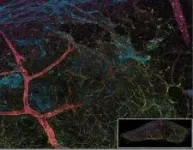(Press-News.org) Along the Tian Shan and Alay mountain ranges of Central Asia, sheep and other domestic livestock form the core economy of contemporary life. Although it was here that the movements of their ancient predecessors helped to shape the great trade networks of the Silk Road, domestic animals were thought to have come relatively late to the region. A new study, published today in the journal Nature: Human Behavior, reveals that the roots of animal domestication in Central Asia stretch back at least 8,000 years - making the region one of the oldest continuously inhabited pastoral landscapes in the world.
The domestication of sheep, goat, and cattle first took place in the Fertile Crescent of Mesopotamia and the nearby mountain zones of western Asia roughly 10,000 years ago, in lockstep with the first domestication of plant crops like wheat and barley. This innovation in human subsistence, known as the Neolithic Revolution, spread northwards to Europe and southwards to Africa and India, transforming human societies across three continents. But until recently, it seemed that this dramatic expansion of domestic plants and animals failed to reach eastward to the rich mountain zones of Central Asia, where - despite their outsized significance in the later millennia of the Bronze Age and beyond - there was little evidence of a Neolithic dispersal.
That changed when a joint team of international scientists, led by Dr. Svetlana Shnaider of Russia's Institute of Archaeology and Ethnography (RAS-Siberia, Novosibirsk) and Dr. Aida Abdykanova of the American University of Central Asia (Kyrgyzstan), decided to revisit rockshelter Obishir V, tucked into a mountain precipice along Kyrgyzstan's southern border with Uzbekistan. The site, which was first discovered and excavated by Soviet archaeologists in the 20th century, had yielded an unusual assemblage of stone tools, some of which seemed to have been used for processing grains. Furthermore, sprinkled throughout the layers of the site's geologic strata were the fragmented remains of what appeared to be sheep and goats.
Could this be evidence of an ancient, undocumented Neolithic movement of domestic animals deep into the interior of Central Asia? To find out, Shnaider and Abykanova partnered with lead author Dr. William Taylor, a specialist in the study of animal domestication at the University of Colorado-Boulder's Museum of Natural History and the Max Planck Institute for the Science of Human History, along with a team of international experts from across Europe and the United States. After radiocarbon dating bones and teeth from the site, it became clear that the oldest cultural layer dated at least as far back as ca. 6000 BCE, or more than 8,000 years ago - three millennia earlier than domestic animals were thought to have reached Central Asia.
Burning, cut marks, and other changes to the animal bones showed that they had been butchered, while patterns of microscopic seasonal layering within the animals' tooth cementum indicated that they were slaughtered in the fall, as is common in many herding societies. But because the bones were highly fragmented, the species could not be identified using standard anatomical analysis. Instead, the researchers applied an interdisciplinary approach using both paleogenomics and collagen peptide fingerprinting to identify the animal remains. Comparing their results with the genomes of wild and domestic sheep species from across Eurasia, the researchers made a shocking discovery.
"With each new line of evidence, it became increasingly clear... these were not wild sheep - they were domestic animals," says Taylor.
For those that have worked for years to understand Central Asia's prehistory, the results are startling.
"This discovery just illustrates how many mysteries still remain regarding the prehistory of Inner Asia - the cultural crossroads of the ancient world," says the Max Planck Institute's Dr. Robert Spengler - a study co-author and author of Fruits from the Sands: The Silk Road origins of the foods we eat.
Future work will be necessary to understand the full impact of the study's findings and their implications for the rest of ancient Eurasia. Shnaider plans to return to Obishir this coming summer to look for clues and to determine whether other domestic animals, like cattle, or domestic plants, such as wheat and barley, also spread to Kyrgyzstan from Mesopotamia in the deep past. With an award from the European Research Council, project partner and co-author Dr. Christina Warinner (Harvard/MPI-SHH) is spearheading an effort to investigate whether these first Central Asian sheep spread elsewhere in the region and whether they were used to produce dairy or wool.
"This work is just the beginning," says Taylor. "By applying these interdisciplinary techniques from archaeological science, we are starting to unlock the clues to Central Asia's past."
INFORMATION:
Ageing and age-related brain disease do not affect women and men in the same way. The adult brain constantly generates new brain cells called neurons from stem cells, a process called neurogenesis. This process is important for learning and cognitive function which declines as the brain ages. Neurogenesis has been extensively studied in animals, but most studies have looked at male animals, raising the question of whether age-related decline in neurogenesis affects both sexes in the same way. To address this, researchers Sally Temple, PhD (sallytemple@neuralsci.org), Kristen Zuloga, PhD (zuloagk@amc.edu) and colleagues at the NY Neural Stem ...
Mutations in the DNA of the cell's energy 'factories' increases the chances of survival for people with bowel cancer, according to a study published today (Thursday) in Nature Metabolism.
Scientists funded by Cancer Research UK have found that patients with colorectal cancer, a common form of bowel cancer, had a 57 to 93% decreased risk of death from their cancer, depending on the presence and type of mitochondrial DNA mutations in their tumours.
The researchers hope that in the future, doctors could use this information to identify patients with more aggressive forms of bowel ...
What The Study Did: This analysis evaluated in-hospital mortality rates for patients with SARS-CoV-2 infection over time and factors associated with changes were examined
Authors: Lyn Finelli, Dr.P.H., M.S., of Merck Research Labs in North Wales, Pennsylvania, is the corresponding author.
To access the embargoed study: Visit our For The Media website at this link https://media.jamanetwork.com/
(doi:10.1001/jamanetworkopen.2021.6556)
Editor's Note: The article includes conflict of interest and funding/support disclosures. Please see the article for additional information, including other authors, author contributions ...
Gorillas usually stand bipedally and rapidly beat their chests with cupped hands in rapid succession. Chest beating is a unique sound because is it not a vocalization, like frogs croaking, but rather it is a form of gestural communication that can be both heard and seen. The emanating drumming sound can be heard over one kilometre away. The presumed function of gorilla chest beats is to attract females and intimidate rival males.
Researchers recorded chest beats and used a technique called photogrammetry to non-invasively measured body size of adult male wild mountain gorillas monitored by the Dian Fossey Gorilla Fund in Volcanoes National Park, Rwanda. They found that larger males emitted chest beats with lower peak frequencies than smaller ones. In other words, ...
The U.S. military veteran population is known to have abnormally high rates of suicide, so health officials have been concerned that the COVID-19 pandemic might elevate risk of psychiatric disorders, particularly among those suffering from post-traumatic stress and related disorders.
A recent national study of more than 3,000 veterans participating in the National Health and Resilience in Veterans Study did find that 12.8% reported post-traumatic stress disorder (PTSD) symptoms related to COVID-19 and 8% said they had contemplated suicide during the pandemic.
However, the same survey, published April 8 in JAMA Network Open, revealed another, startling finding. A full 43.3% ...
What The Study Did: This survey study uses self-reported data from a national study of veterans to assess the association of symptoms of posttraumatic stress disorder with posttraumatic psychological growth (these are positive psychological changes such as an appreciation of life and personal growth) among U.S. veterans during the COVID-19 pandemic.
Authors: Robert H. Pietrzak, Ph.D., M.P.H., of the U.S. Department of Veterans Affairs National Center for Posttraumatic Stress Disorder and the VA Connecticut Healthcare System in West Haven, is the corresponding author.
To access the embargoed study: Visit our For The Media website at this link https://media.jamanetwork.com/
(doi:10.1001/jamanetworkopen.2021.4972)
Editor's ...
It may be possible in the future to use information technology where electron spin is used to store, process and transfer information in quantum computers. It has long been the goal of scientists to be able to use spin-based quantum information technology at room temperature. A team of researchers from Sweden, Finland and Japan have now constructed a semiconductor component in which information can be efficiently exchanged between electron spin and light at room temperature and above. The new method is described in an article published in Nature Photonics. ...
The millions of people who have chronic sinusitis deal not only with stuffy noses and headaches, they also commonly struggle to focus, and experience depression and other symptoms that implicate the brain's involvement in their illness.
New research links sinus inflammation with alterations in brain activity, specifically with the neural networks that modulate cognition, introspection and response to external stimuli.
The paper was published today in JAMA Otolaryngology-Head & Neck Surgery.
"This is the first study that links chronic sinus inflammation with a neurobiological ...
Expressive language sampling (ELS) is a useful tool for measuring communication development in youth with Down syndrome, a END ...
Cyberbullying already accounts for one in four cases of bullying and, according to the latest UNICEF report issued on the occasion of 'Safer Internet Day', it affects at least two students per class in Spanish schools.
In this regard, the Laboratory of Studies on Coexistence and Violence Prevention at the University of Cordoba, under the direction of professors Rosario Ortega-Ruiz and Eva M. Romera, has just published a study examining family communication and its impact on cyber-gossip and the excessive use of social media-two of the main factors with the greatest influence on cyber-bullying. Their results point in the same direction: an atmosphere of trust in the family is an antidote to this type of behaviour, reducing the risk of schoolchildren engaging inproblematic ...


